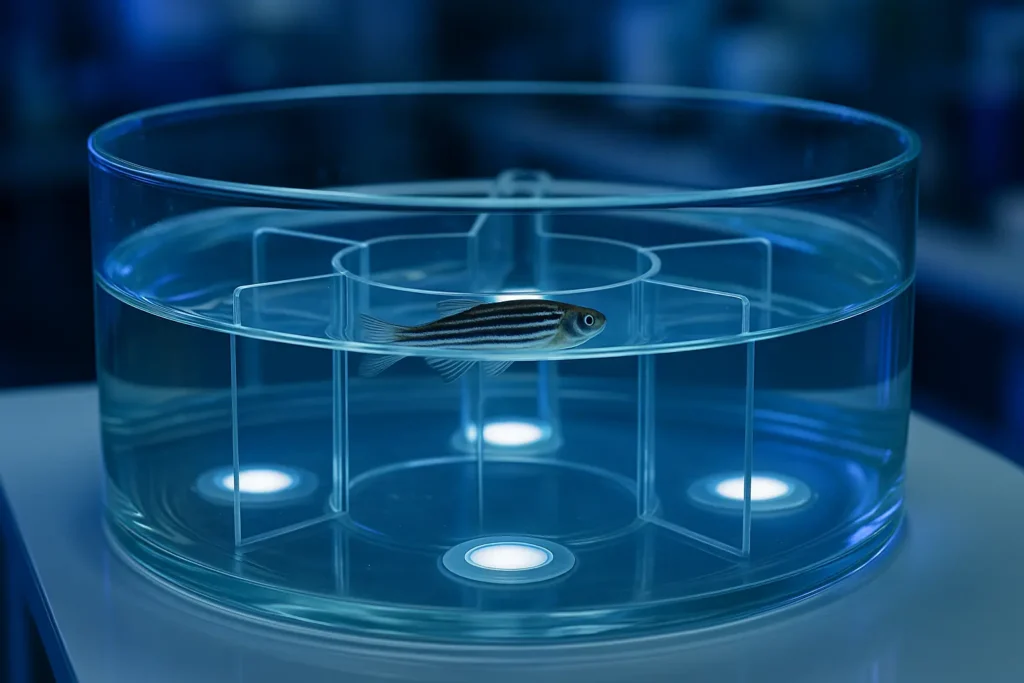

In the quest to quantify cognition, timing is everything. Among the metrics that define executive performance in behavioral neuroscience, Correct Response Latency (CRL), the time it takes to make the right choice after a stimulus—is a powerful and revealing tool. In the context of the Zebrafish 5-Choice Maze, this metric offers a real-time readout of decision-making speed, attentional capacity, and neural efficiency.
The Zebrafish 5-Choice Maze, inspired by the human and rodent 5-CSRTT paradigm, allows zebrafish to demonstrate how they perceive cues, evaluate options, and act. CRL is the temporal thread that ties perception to action, not simply indicating that a correct choice was made, but how swiftly that decision unfolded. In high-throughput assays targeting cognition, CRL is emerging as a behavioral cornerstone.
Definition:
Correct Response Latency is the elapsed time between the presentation of a stimulus (typically a light cue) and the zebrafish’s entry into the correct chamber.
It captures the interval during which the fish perceives the cue, processes it, and initiates a motor response toward the correct target.
Significance:
Importantly, CRL measures cognitive timing, not just locomotion—making it distinct from swim speed or total distance traveled.
CRL is a temporal indicator of cognitive throughput. Zebrafish with faster CRLs are likely:
This metric is crucial in assessing how quickly a subject can integrate stimulus perception, short-term memory, and action selection—functions governed by midbrain and telencephalic circuits.
A long CRL may not always reflect indecision—it can indicate attentional disengagement or divided focus. Zebrafish under mild distraction or with altered cholinergic tone may:
Thus, changes in CRL can reveal subtle lapses in cue detection or sustained attention—even when response accuracy remains intact.
As trial sessions progress, CRL often increases:
This dynamic measure allows researchers to identify when and how cognitive resources become taxed—insightful for stress, aging, or multitasking studies.
If a zebrafish hesitates before approaching a rewarded chamber despite knowing the correct answer, it may reflect:
In these cases, CRL acts as a behavioral lens into motivational drive and decision hesitancy.
In operant behavioral neuroscience, Correct Response Latency (CRL) serves as a fine-tuned indicator of the subject’s perceptual acuity, cognitive processing speed, and decisional readiness. Within the Zebrafish 5-Choice Maze, CRL captures the interval between cue onset and entry into the correct chamber, representing a real-time behavioral output of internal cognition.
To ensure that CRL data are meaningful, precise, and replicable, researchers must carefully structure their experimental design, timing parameters, and response tracking protocols.
CRL is calculated as:
This latency reflects:
Importantly, CRL should only be measured on correct trials, as it reflects the time needed to make a correct decision, not a guess or error.
A well-calibrated 5-choice operant maze setup is essential. The core elements for capturing CRL accurately include:
Why this matters: Accurate timestamp pairing between stimulus onset and chamber entry is essential to ensure millisecond-level resolution of behavioral dynamics.
The correct timing sequence is crucial for isolating CRL:
Key insight: CRL is only recorded if the fish enters the correct chamber after cue onset, and within the allotted response window (e.g., 5–10 seconds).
Advanced tip: Use cumulative distribution functions (CDFs) to compare CRL curves across treatment or genotype groups.
CRL can be affected by variables not directly related to cognitive performance. These must be controlled or accounted for during interpretation:
| Confound | Potential Impact on CRL | Mitigation Strategy |
| Swim speed | Slow movement may mimic cognitive delay | Normalize CRL to average swim velocity |
| Chamber preference | Faster responses due to bias | Randomize cue locations, use symmetrical layout |
| Cue visibility | Dim cues cause perception delay | Use uniform cue brightness and contrast |
| Stress or arousal | Elevated CRL under anxiety | Acclimate animals, control light/sound levels |
| Habituation effects | Shorter CRLs with over-familiarity | Limit repeated cues or trial count |
To probe cognitive flexibility, researchers can modify the protocol and examine CRL dynamics:
In all these cases, CRL becomes a multidimensional indicator, reflecting not only how fast the fish responds, but under what cognitive demands that speed is maintained or compromised.
Correct Response Latency should be interpreted alongside other behavioral metrics for context:
| Combined Metric | Interpretation |
| Low CRL + high accuracy | Efficient processing and strong cue detection |
| Low CRL + low accuracy | Impulsivity or speed–accuracy tradeoff |
| High CRL + high omissions | Fatigue, disengagement, or attentional decline |
| Rising CRL over time | Cognitive fatigue or task saturation |
Analytically, CRL data are often used in:
CRL provides a dose-sensitive indicator of how compounds affect processing speed. For example:
Application: Early screening for cognitive enhancers or side-effect profiling of psychoactive agents.
CRL helps explore Reaction time under pressure,Temporal decision thresholds, and Speed-accuracy trade-offs in goal-directed behavior.
By modifying ITI, cue salience, or reward predictability, CRL becomes a scalable readout of cognitive control.
In zebrafish models of:
These latency profiles help differentiate behavioral phenotypes with high translational potential.
In behavioral economics studies, CRL offers insight into:
Use case: Modeling cost-benefit decision-making under limited reward conditions.
On the Conduct Science YouTube Channel, zebrafish can be observed responding to cues in real-time. Researchers can analyze:
This dynamic behavior, paired with timestamped logs, helps researchers contextualize decision-making beyond correctness.
Correct Response Latency (CRL) is far more than a measure of reaction time, it is a behavioral chronometer of neural efficiency, attentional integrity, and decisional readiness. In the structured operant environment of the Zebrafish 5-Choice Maze, CRL reflects how quickly the subject can detect a cue, process it, commit to an action, and execute that action successfully.
What makes CRL uniquely valuable is that it sits at the intersection of perception, cognition, and motor planning. It doesn’t merely tell us if a zebrafish made the correct decision, but how fast that decision unfolded, revealing the temporal dynamics of cognition that are often invisible in binary outcome measures like accuracy or error rate.
CRL is especially powerful because it is:
Across domains, from pharmacology and stress studies to neurodevelopmental research and aging—CRL provides a sensitive, adaptable, and ethically flexible behavioral readout. It is particularly well-suited for detecting:
When paired with other metrics like accuracy, premature responses, and omissions, CRL becomes part of a multidimensional behavioral signature enabling researchers to construct fine-grained cognitive profiles of zebrafish and apply them to broader models of vertebrate cognition.
In short, CRL offers more than numbers, it offers insight. It translates reaction into reflection, latency into learning, and hesitation into hypothesis. For researchers using the Zebrafish 5-Choice Maze, Correct Response Latency is not just a tool, it’s a neuroscientific lens on cognition in motion.

Monday – Friday
9 AM – 5 PM EST
DISCLAIMER: ConductScience and affiliate products are NOT designed for human consumption, testing, or clinical utilization. They are designed for pre-clinical utilization only. Customers purchasing apparatus for the purposes of scientific research or veterinary care affirm adherence to applicable regulatory bodies for the country in which their research or care is conducted.